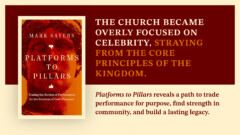This is the second part in a series examining The Radical Reformission by Mark Driscoll. The first article, which you can read here, served as an introduction to the book. In the introduction to the book, Driscoll introduced himself in a brief biography and then provided three formulas that explain how different churches react to the competing forces of gospel, culture and church. He showed that Gospel + Culture – Church = Parachurch, Culture + Church – Gospel = Liberalism and Church + Gospel – Culture = Fundamentalism. “This book focuses on issues related to the scriptural content of the gospel and the cultural context of its ministry, and I write out of my sincere love as a pastor for Christians, churches, lost people, and culture” (page 22).” You will recall that Driscoll defines Reformission as follows: “a radical call for Christians and Christian churches to recommit to living and speaking the gospel, and to doing so regardless of the pressures to compromise the truth of the gospel or to conceal its power within the safety of the church” (page 20). The goal of Reformission is “to continually unleash the gospel to do its work of reforming dominant cultures and church subcultures” (ibid).
Today we will look at Part 1 of this book, which is comprised of three chapters. I will provide an overview of the content of each of the chapters and then a little bit of analysis. It should be noted that each chapter follows a pattern. Driscoll begins with remembering the teachings of Scripture; he then repents of values, beliefs and behaviors which are sinful; redeems the future by obeying God; and reflects with God through the study of Scripture, both alone and in community with others.
eat, drink and be a merry missionary
Uppercase titles must be a throwback to modernism, as many books meant to appeal to a postmodern generation eschew them, preferring the lowercase. The Radical Reformission features lowercase chapter headings opposite trendy photographs of beer, cappuccinos and the like.
I’ve written two sentences and I am already off-topic. The first chapter is subtitled “imitating the reformission of Jesus.” It begins with a brief and somewhat irreverent overview of the store of redemption as told in the Bible. Here is a small sample. “[God] starts over with another decent guy named Noah, who nevertheless ends up having a bad day, gets drunk and passes out naked in his tent like some redneck on vacation” (page 28). Or again, “And to top it all off, God comes to earth. He has a mom whom everything thinks is a slut, a dad whom they think has the brilliance of a five-watt bulb for believing the “virgin birth” line, and brothers who likely pummel him frequently, because even God would have to get at least one wedgie from his brothers if he were to be fully human. The God-man goes through puberty and likely goes through that weird vocal transition in which, in the course of one syllable, a young man can go from sounding like Barry White to sounding like Cindy Brady.” (page 29).
He goes on to relate a story of when he was challenged by a homosexual friend to visit a gay bar. He went with his friend and learned “that reformission requires Christians and their churches to move forward on their knees, continually confessing their addictions to morality and the appearance of godliness, which does not penetrate the heart and transform lives” (page 35). In short, God does not seek merely to create a team of good and decent people, but to create a movement of loving, holy missionaries who are comfortable around lost sinners and who look far more like Jesus than many pastors do.
Moving on to share the story of “the woman at the well,” Driscoll says that “Reformission is ultimately about being like Jesus, through his empowering grace” (page 39). We have to know that neither the freedom of Christ nor our freedom in Christ is intended to permit us to dance as close to sin as possible without crossing the line. Instead, they are intended to allow us to dance as close to sinners as possible by crossing the lines that seperate the people God has already found from those he continues to seek. Does this mean that Christians are more likely to sin? No, because the way to avoid sin is not to avoid sinners but to stick close to Jesus.
and now, the news
To begin the second chapter, Driscoll tells the reader about Street Talk, the radio program he co-hosted for six years. The hosts boasted that they would never back down from a difficult question. Eventually the show came under fire from within the church when they addressed the issue of oral sex. What he learned from his experience is that “as the gospel moves into new cultures in our day, and as new cultures emerge, we must struggle to sift out what is cultural and what is scriptural” (page 47). He poses a large list of questions that may have been foreign to previous generations, but which Christians must be prepared to answer. Examples are “can I continue being a professional blackjack player now that I am a Christian?” and “Can I get breast implants as my husband’s Christmas gift?”
Driscoll repents for the nostalgia many Christians are prone to adhere to. “A naive romanticism in each of use desperately wants to believe there was a time after Genesis 2 when the world was a wonderful place to live, when things were better and easier than they are today. This powerful delusion enables to excuse our laziness and failure to be about reformission because of the difficult days we live in” (page 50). The truth is, of course, that there have never been “good old days.” The history of the church is one filled with sin and sinners, but with God’s work prevailing nonetheless. Traditionalism, at its best, is informed by a grasp of the best and worst of what Christians have done and believed in the past. At its worst it fail to distinguish between what is biblical and what is cultural, clinging to what is outdated and ineffectual. The result is a church that has all the right answers to all the wrong questions. The opposite to traditionalism, innovation, is equally dangerous, as churches seek relevance at the expense of the gospel.
When the church has removed the stains of traditionalism and innovation, it is ready to contextualize the gospel in a way that is to the content of Scripture and the context of the ministry. Driscoll concludes the chapter by listing several “signposts” that he has found useful in directing people to Jesus. Among them are, “the gospel infuses daily activity with meaning” and “the gospel is about Jesus as the means and end of our salvation” (page 60,61).
shotgun weddings to Jesus
The third chapter discusses evangelism in a reformissional context. What was once considered effective evangelism, methods such as door-to-door and street preaching, are becoming increasingly inappropriate in our cultural context. Driscoll feels that the best approch in our culture is to invite people to see the transformed lives of Christ-followers, for these people are “the greatest argument for, and the greatest explanation of, the gospel” (page 68). He then provides an apologetic for the “belong and believe” mentality popular in emergent churches. Unbelievers are invited to participate in church community and activities and eventually come to faith, perhaps not in a moment, but over time.
Our society seeks experience. We live in an experience economy, where products that are most successful are sold not on the basis of their usefulness, but on the basis of the experience they can provide. But even more than a mere experience, people want to participate in an “immersion experience,” one in which they are not spectators but participants. Thus churches need to allow unbelievers to participate in immersive experiences. For example, “allowing people, while the sermon is being preached, to paint or draw scenes from the sermon text to be displayed after the service, permitting people to come forward for communion when they feel prepared, allowing people in the congregation to call out the songs they would like to sing next, or permitting congregants to interrupt the sermon to ask questions of the preacher” (page 73).
Here, then, are the benefits of reformission evangelism:
- It blurs the lines between evangelism and discipleship
- Conversion to Jesus is a conversion of old lifestyles to his mission of reaching the lost.
- Conversion is more than mental assent to facts, but a conversion of the entire life.
- Reformission insists that evangelism is more than an activity, but is a lifestyle.
In the “repent” section of this chapter Driscoll repents of self-righteousness and encourages the reader to do the same. He then shows, using various statistics, how people in our society are increasingly desiring community, but at the same time are becoming more and more isolated. “Isn’t it odd,” he asks, “that we are apparently becoming a nation of attractive people who sit at home alone at night with our pets, watching television shows about relationships and taking medication for our depression brought on by our loneliness? Meanwhile, our neighbors, whom we do not know, are spending their evenings in much the same way” (page 82).
Analysis
There is a lot of content here to consider. Perhaps in the future I should attempt fewer chapters at a time. Regardless, there were a few points of interest I would like to discuss.
First, I am not entirely comfortable with the irreverent summary of Scripture in the first chapter. This seems to me to be an attempt to be cool and engaging more than an effective method of summarizing the history of redemption. Perhaps I am too sensitive about such matters, but I see little benefit in treating biblical truth so flippantly.
Second, Driscoll outlines the pattern he used to begin his church as if it is the Bible’s teaching on church-planting. “When God called me to plant our church, Mars Hill Church, I had worked for nearly two years overseeing a college ministry, but I had never been a pastor or even been an official member of any church. I was unsure of how to begin a church, and so I simply read the Bible and tried to imitate how Jesus gathered the first workers for his ministry. In the opening chapter of John’s gospel, I saw that Jesus began his ministry not with a large crowd, a formal program, or an organized event but rather by informally building friendships with a few men. Once those men trusted him, their friends, family members, and coworkers also became his followers. This simple pattern seemed attainable” (page 66-67). So Driscoll began inviting people into his home and soon gathered what became a growing, thriving congregation.
My concern is that this does not account for the message Jesus brought with him. It would also be difficult to defend this as a normative teaching on the biblical way of beginning a church. Finally, I am not even sure that it is accurate, beyond the statement that Jesus began with a small group of disciples. There seems to be little evidence that Jesus used this “Mary Kay” approach to grow His ministry.
Third, I do not sense a consistent pattern in which Driscoll will address the unanswered question from the first chapter, which is Gospel + Culture + Church = ?. This first section was called “loving your Lord through the gospel” and the second (and final) section is “loving your neighbor in the culture.” I’m wondering if he will adequately explain how reformission provides the solution to the problems presented in the first three formulas.
Fourth, while I understand the emphases on community, mission and relationship that are always present in books of this nature, I am gratified to see there is a real emphasis on theology as well. This is something that has been sorely lacking in many of the other books I have read on this topic. While many giving a passing nod to sound theology, the authors seem to deny this very thing throughout their books. Driscoll clearly seems to appreciate the importance of orthodox theology.
Fifth, I appreciated Driscoll’s comments that the way to avoid sin is not through system of rigid rules and scrupulous conformity to external standards, but through walking closely with Jesus. This is a liberating truth, I am sure. Where I am less sure is that he will give wisdom on “how far is too far.” When does our cultural engagement work against us by denying our profession? Is a visit to a gay bar not a tacit endorsement of the lifestyle and behavior of those present? I foresee a similar concern with the “belong and believe” mentality. At what point do we agree that we cannot allow a person to belong among us? Surely there are times when we need to sever ties with certain people.
Finally, I enjoyed Driscoll’s comments on traditionalism and innovation. I agree that they are equally dangerous and we are prone to adhere to one or the other. He writes about churches that have all the right answers to all the wrong questions. That is a damning indictment of many churches I have seen, as they have the answers only to the questions unbelievers were asking forty or fifty (or one hundred and fifty) years ago. He is equally hard on innovative churches that become so relevant that they are unable to call lost people from or to anything because they have lost what is supposed to make them distinctive.
On the whole I am enjoying the book, but I’m not entirely sure at this point where it is going. I will check in again when I have completed another couple of chapters.










